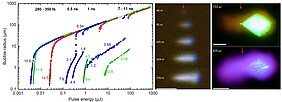The study systematically analyzes for the first time how ultrashort laser pulses in water and transparent biological tissue generate precisely adjustable energy density states - from nanoeffects to extreme values of 400 kJ/cm³ and combines this with a detailed discussion of the underlying mechanisms. These findings are groundbreaking for applications in eye surgery, material processing and nanoparticle generation. The discovery of a new “fine-tunable” mode of nonlinear energy deposition with low-cost UV nanosecond lasers is of particular interest, enabling precise nanoeffects - something previously only achievable with expensive femtosecond technology
This work provides new principles for the optimization of laser-induced material effects in science and application and outlines perspectives for future experiments and theoretical modeling..
Title: Laser-induced plasma formation and cavitation in water: from nanoeffects to extreme states of matter
Published in: Reports on Progress in Physics, 31. July 2025
DOI: 10.1088/1361-6633/adedb3












